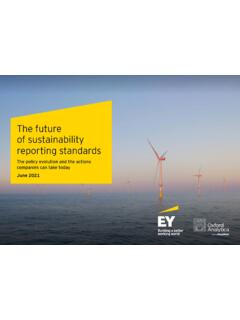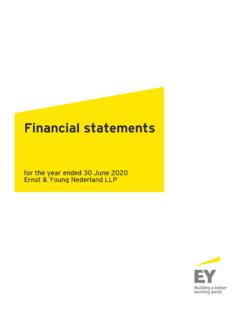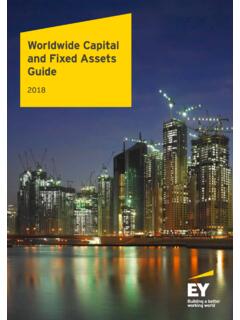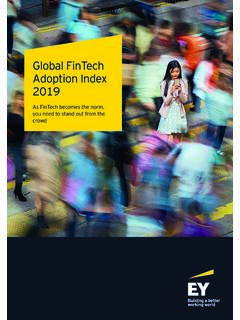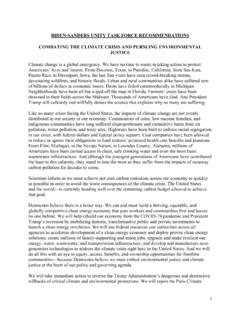Transcription of Global regulatory outlook 2021 (pdf) - EY
1 2021 Global bank regulatory outlook How the COVID-19 pandemic has changed Global banking s vision for 2021 and beyondContentsIntroduction 3 Now: a look at the 2021 Global regulatory agenda 4 Next and beyond: what to expect from the post-pandemic regulatory landscape 7 Conclusion 112A year ago, industry outlooks were blissfully ignorant of the pandemic. Twelve months later and it seems that the pandemic will continue to shape current events and have residual impact for some time to come. In 2021, will this external, seismic, Global event cause governments and policymakers to overcome divergent tendencies and deliver more joined up solutions in the spirit of common cause, or will it reinforce recent trends of fragmentation and protection of regional and national interests?
2 The immediate prospects are not encouraging. In Europe, although a trade and cooperation agreement with the UK on the terms of its future cooperation with the European Union (EU) has been reached, the consequences for financial services remain a big unknown. In the US, due to the election and its aftermath, the new administration is clarifying its policy and supervisory priorities; and in Asia-Pacific (APAC), geopolitical tensions between China and the US show no signs of financial services industry is considerably stronger than during the 2008 crisis , but the change management demands caused by the pandemic have tested risk management capabilities and regulatory responses.
3 We look at the immediate environment (Now) and a little further ahead (Next and Beyond) to identify likely regulatory action. For a more detailed analysis of the future direction of travel, see EY s paper on the impact of the COVID-19 pandemic on financial 1 The COVID-19 Pandemic: Potential impacts on financial regulation , EY January Global bank regulatory outlookThe pandemic had an immediate impact on several key areas of bank activities. These have required significant changes in business processes and modifications in regulatory and supervisory oversight in the near-term. The COVID-19 pandemic response Terms that are now commonplace in regulatory discussions forbearance, compassionate collection, and business interruption were hardly top of mind at the start of 2020.
4 Customer protection has taken on added meaning as conduct regulators focus on protecting the vulnerable and ensuring they gain access to payment relief while the pandemic continues and until more normal economic activity resumes. Collection and recovery activities must be reappraised, including those that are outsourced, with revisions to the process and the solutions offered to customers. Banks must now proactively distinguish viable distressed customers from non-viable ones by using borrower-specific debt restructuring and forbearance practices. It will be important for lenders to understand personal circumstances and to reflect them in more flexible arrangements that accommodate what customers can realistically firms transition from crisis management they should anticipate and prepare for an increase in complaints, regulatory and political scrutiny and potential legal action.
5 Regulators will be alert to the increased likelihood of mis-selling arising from commercial pressures in a difficult business environment. The conduct authorities are also focused on whether insurers are dealing with claims in a manner that is unfair to vulnerable groups, particularly those related to business continuity. Firms should demonstrate how decisions were made on a fair, equitable, and inclusive basis, and maintain full Sustainability will return to center stage in 2021. An immediate boost is the new Biden administration s decision to re-engage in Global climate talks, with both Washington and Brussels talking about linking trade and climate agendas.
6 This is accompanied by renewed worldwide regulatory pressure for adoption of sustainable finance frameworks and growing support for the agenda from large international banks, investors and corporates. The foundation of climate risk regulation must now be put in place via a taxonomy that can serve as a list of green economic activities and a basis for a series of disclosure requirements for corporates, financial market participants and financial products. Regional and national efforts are underway, and we expect to see further momentum throughout the year. For example, Singapore and Hong Kong have been driving disclosure and taxonomy initiatives in APAC.
7 The Monetary Authority of Singapore (MAS) is developing standards for insurance, banking and asset management sectors,2 and the Hong Kong Securities and Futures Commission (HKSFC) has issued proposals for climate risk disclosure by fund managers and with other regulators and is starting on a sector-wide taxonomy to be aligned with the EU and Chinese The evolving landscape is explored further in EY s recent paper on climate change 2 Consultation Paper on Proposed Guidelines on Environmental Risk Management (Banks), MAS June Consultation Paper on the Management and Disclosure of Climate-related Risks by Fund Managers, HKSFC October Climate change and sustainability: Global regulators step up the pace, EY January : a look at the 2021 Global regulatory agenda 4 Technology and data Regulators will want to renew efforts to transform supervisory capabilities through expanded use of technology and data.
8 The UK Financial Conduct Authority s (FCA s) digital regulatory reporting (DRR) initiative is already moving ahead via various pilots and proof of concept exercises. More comprehensive and real-time data sets could be within reach of supervisors. However, SupTech and RegTech progress might be offset by other data challenges in the coming months, some of which are compounded by geopolitical issues of the day. In Europe, Brexit will continue to be a major complication, with the European Commission (EC) now faced with deciding if it will adopt any adequacy decisions on data regulation as part of the Brexit process. The US will be trying to achieve some degree of consistency on data privacy within its borders while also pursuing international data access standards that can facilitate enforcement actions.
9 On both sides of the Atlantic a strong sense prevails that Big Tech firms need to be more comprehensively regulated, though the US and the EU have different approaches to privacy. APAC is already caught up with various data localization issues exacerbated by China-US geopolitical accountability across artificial intelligence (AI) and machine learning (ML) applications will feature across post-pandemic supervisory reviews, given that there are already concerns about decisions taken on allocation of relief measures, loan decisions and forbearance actions. AI and ML regulatory frameworks are developing fast in APAC and the EU, focusing on fairness and riskRegulators will be focused on supervisory stress testing and banks own internal stress testing in late 2020 and 2021 as a means of testing the asset quality of banks and understanding capital vulnerabilities.
10 It is not evident that regulators are changing their stress test methodologies significantly, but COVID-19 exposures and the environmental, social and governance (ESG) agenda are creating new data and stress-testing demands. Banks own methods will need to expand to match their evolving credit review processes that include deeper sectoral and supply-chain analysis and a focus on borrowers that are more highly leveraged. The Group of Central Bank Governors and Heads of Supervision (GHOS), the oversight body of the Basel Committee, has signaled an end to the post-2008 financial crisis policy The revised timeline for Basel III implementation has been in place since March 2020, and the GHOS has stated that any further potential adjustments to Basel III will be limited in nature and consistent with ongoing evaluation work.



